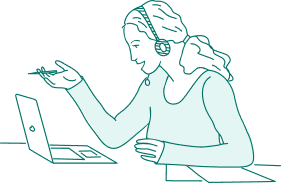Invisible Disabilities Awareness Week 2025: My Life With a Hidden Disability

In honor of Invisible Disabilities Week® (October 19–25), I want to share what life is like living with a disability you can’t always see. The week, organized by the Invisible Disabilities Association (IDA), recognizes people living with chronic pain, neurological conditions, and other challenges that aren’t visible to others. It’s a time to be seen, understood, and valued.
I have cerebral palsy (CP), but not in the way most people expect. Many assume cerebral palsy always means using a wheelchair or another assistive device. When they don’t see that, they often assume I don’t face any challenges.
Cerebral palsy is a neurological condition that affects movement, muscle tone, and posture. It can look different for everyone. My disability isn’t always visible, but it affects my life every day.
That’s why Invisible Disabilities Week matters. It reminds people that not every disability can be seen and that understanding starts with awareness.
What Is an Invisible Disability?
Invisible disabilities, also called hidden disabilities, are conditions that aren’t immediately obvious but can significantly impact individuals on a daily basis. These disabilities may include chronic pain, cognitive impairments, or neurological disorders.
Because invisible disabilities aren't outwardly apparent, people who live with them often face misunderstanding, stigma, or a lack of support.
Here’s a list of hidden disabilities often linked with cerebral palsy:
- Chronic pain from muscle stiffness or joint problems
- Speech and communication difficulties
- Seizure disorders (epilepsy or recurring seizures)
- Learning disabilities
- Mental health challenges like anxiety or depression
Unfortunately, there is a lack of understanding of coexisting conditions that come with cerebral palsy. In fact, adults with nonvisible disabilities are typically not supported by the community. Many people focus on more visible issues.
Challenges of a Hidden Disability
The challenges of nonvisible disabilities can feel overwhelming. The daily pain and fatigue many of us go through can be undermined by comments like “You look fine” or “Why are you having another lazy day?”
These comments reflect a lack of understanding and empathy, which can leave some people feeling ignored. Even when they’re not intended as bullying, remarks like these can be deeply discouraging.
It’s important for people to understand the wide range of challenges and symptoms of cerebral palsy. These disabilities don’t exist on their own — they intersect with other parts of a person’s identity and shape their experiences.
For me, living with cerebral palsy and being part of the LGBTQ+ community means facing additional layers of discrimination. Recognizing these overlaps is so important for creating support systems that include everyone and meet real needs.
Tools for Navigating Hidden Disabilities
Navigating life can be challenging for people with hidden disabilities, especially when their needs aren’t immediately visible. Below are several tools I find helpful.
Using the Spoon Theory to Explain Hidden Disabilities
As someone who lives with chronic pain, I often turn to Christine Miserandino’s The Spoon Theory to explain my limited energy.
The spoons represent the amount of energy I have for the day, and the number of spoons I start with determines just how much my body will allow me to do. Some days, I have only a few spoons, which may cause me to accomplish less than on other days.
This theory highlights the daily struggle of balancing what my body can handle with what it demands of me.
“The difference in being sick and being healthy is having to make choices or to consciously think about things when the rest of the world doesn’t have to. The healthy have the luxury of a life without choices, a gift most people take for granted.”
– Christine Miserandino, author of The Spoon Theory
Throughout the day, tasks that may seem simple to others, like doing housework, running errands, commuting, or socializing, can drain a significant amount of my energy.
Each task, regardless of how small, often takes away my spoons and leaves me with less energy for the things I truly enjoy.
During my years of playing soccer, I learned that a single game could consume most of my spoons for the day. I had to listen to my body and pace myself, knowing I had to push without overdoing it.
The spoon theory has become a powerful way for me to explain my energy levels and the hidden struggles of living with invisible disabilities, offering insight into a reality many may not fully understand.
Getting Help From the Hidden Disabilities Sunflower
One resource that’s made a difference for many is the Hidden Disabilities Sunflower program.
Introduced in 2016 at Gatwick Airport near London, England, this initiative provides hidden disability sunflower lanyards to show the wearer may need extra help.
These sunflowers are now recognized worldwide in airports, railways, and other public spaces, helping to promote invisible disability awareness and ensure staff are trained to assist.
As someone living with cerebral palsy, I’ve often struggled in public spaces because my disability isn’t obvious. There have been times when a little extra understanding would have gone a long way.
Programs like the Hidden Disabilities Sunflower make it easier to get support without constant explanations. They offer not just help, but dignity, making life a little more manageable for those of us with hidden disabilities.
How to Spread Awareness During Invisible Disabilities Week
Invisible Disabilities Week is about action as much as awareness. Everyone has a role in challenging assumptions, promoting understanding, and helping make hidden disabilities more visible.
Here are 5 ways to get involved this year:
- Share your story: Post about your experiences or support for others using #InvisibleDisabilitiesWeek and #SeeTheInvisible.
- Use social media tools: Add an Invisible Disabilities Week badge or social media frame to your profile photo.
- Wear blue: A blue shirt, ribbon, or wristband can start a conversation about invisible disabilities.
- Join the movement: Visit invisibledisabilities.org to connect with others, learn, and share resources.
- Amplify other voices: Support friends, coworkers, or family members who live with hidden disabilities.
Spreading awareness helps reduce stigma, encourage understanding, and create communities where people with invisible disabilities feel seen and supported.
Increasing Invisible Disability Awareness
All my challenges and each small victory have brought me to one of my passions — raising awareness and supporting others living with an invisible disability.
By sharing my experiences and providing resources, I hope to help others navigate the unique challenges of living with a disability that isn’t immediately visible. Everyone deserves understanding and support.
If your child has cerebral palsy, know that help is available. Contact us at (855) 220-1101 to learn more.

